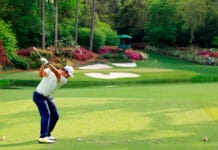It’s a cry that’s been heard regularly around the golfing world for all of this century, and before. “How can we stop these guys hitting it so far?”
From superstars like Jack Nicklaus to tournament directors at all levels and course managers around the world, the challenge for twenty years or more has been what to do about the distance top players gain, especially off the tee.
They all know that technological developments in both clubs and balls, combined with golfers of all abilities consciously improving their strength and flexibility mean the golf ball is going further. At the elite level of the game especially, extra length off the tee goes against the fundamental principle of the game, as outlined in the Rules of Golf.
“Golf is a challenging game in which the success should depend on the player’s judgement, skills and abilities.”
The Equipment Rules essentially lay down the same thought, namely “to protect the traditions of the game, to prevent an over-reliance on technological advances rather than on practice and skill, and to preserve skill differentials throughout the game.”
The conclusion from the recently published Distance Insights, a joint venture from golf’s overseers, the R and A and the USGA, is that “it is essential this remain true for play at the diverse golf courses across the world, without the need for them to keep getting longer.”
While there are many of a certain age who experience the opposite problem, i.e. golf courses becoming too long for them as they age, the people who administer the game around the world are determined to future proof the sport.
They know that if golf combats technology and player strength with just longer golf courses, the problem will never be solved. More land would be required, thus making facilities and the cost of playing more expensive. More developed golf course land means more water and more chemicals to maintain it. It also means a slower game.
The R and A and the USGA want golf to have less impact on the environment, be more financially accessible to all sectors of society, and they want people to play it faster.
You don’t need a data summary to know that today’s elite players smack it way further off the tee than before. But here are the numbers anyway: by the end of last year, the average drive of the 20 longest hitters from both the PGA Tour (USA) and the European Tour had increased to 310 yards, with the average driving distance on both tours at 294 yards. Since 2013, these distances have increased at the rate of one yard per year. Only 25 years ago those numbers were 278 and 263 yards respectively.
While there is no such data available for recreational players, it’s well understood that the average drive for a club golfer nowadays varies from 185 to 250 yards. Ninety years ago, those numbers were 130 to 180 yards.
If the reasons for those distance increases are allowed to remain unfettered, then it doesn’t take much to predict how far golfers might be hitting the ball in just a further 30 years. If the current one yard per annum increase remains, the 2050 equivalent of a Brooks Koepka or Rory McIlroy or even Ryan Fox won’t be averaging 315 yards off the tee, but rather 345. The 400-yard par 4, already just requiring a drive and a flick with a lob wedge anyway, will become an almost driveable proposition. Golf was not intended to be played that way.

As Distance Insights reports, “the unifying principle is that success should depend on a golfer’s skill and judgement using 14 different clubs, many elements of skill, and making constant strategic choices.”
The report goes on to say that while “hitting distance is a valued skill, the issue is whether the skill of hitting distance is on a path to overshadowing the other important skills in golf.”
The matter of how much land is used for a golf course is a stark contrast between eras. Courses built between 1900 and 1980 occupy on average around 150 acres (60 hectares). Those opened in the last 40 years average more than 205 acres or 82 hectares. The implications for cost, water use, chemicals and energy are obvious.
The R and A and the USGA have concluded the current thirst for more distance cannot go on or else the game will become unsustainable and less challenging, therefore losing its appeal.
Therefore, those that run the game want to consider reigning in a player’s ability to hit it further and further, and the reality is that the only way to do this is through equipment.
There are two considerations;
- to look at the conformance specifications for both clubs and balls, not to reduce the current hitting distances, but to limit further increases.
- To see whether a Local Rule option to specify the use of certain clubs and balls would result in shorter hitting distances.
Both broad proposals are not without pitfalls. The concept of either turning back the clock or putting a stop to technology advances would be anathema to players who have enjoyed the pleasures that big-headed drivers, hybrid rescue clubs and the 2 piece ball have brought to the game since Taylormade gave us their first “metalwoods” in the early 1980s.
But there will be no decisions for some time yet. Golf’s governing bodies will “assess potential future solutions” but equipment manufacturers are being told to regard Distance Insights as notice under the Equipment Rulemaking Procedures.
That means topics that have the potential to lead to an Equipment Rule change will be researched in the next year before any draft proposals are published for feedback and discussion.
On matters such as these, there will always be conflicting interests. Players at all levels have always wanted, and will always want, to hit the ball further.
They have, through a combination of technology, fitness and agronomy, succeeded brilliantly in the last 100 years. The game is much easier – usually – with a wedge in your hand for the second shot and not a 5 iron.
But it can’t go on forever. Golf courses are expensive beasts to build and maintain. Unchecked technology coupled with bigger, fitter and stronger human beings will make more and more courses drive, pitch and putt exercises – far from the “skill and judgement using 14 different clubs” concept.
Who knows what solutions may be found, but remember the discussion and rule changes about the “trampoline effect” and the coefficient of restitution (COR) of drivers about 15 years ago? Then it was decreed that no driver could have a COR more than 83. In other words, the driver face could release up to 83 per cent of its energy onto the ball at impact. The higher the COR, the more the ball will fly. Is it possible the COR of future drivers may be reduced to ensure driving distance is kept in check?
There will be howls of protest as there were in 2006, but after all the consultation and feedback it may be one reasonably straightforward way of dealing with the issue. Equipment makers and players searching for more distance will fight any such call.
It will not be an easy battle for the authorities to win. But the R and A and the USGA both know that for the sake of the game, the masochist tendencies of many of its participants will just have to be reigned in.
















